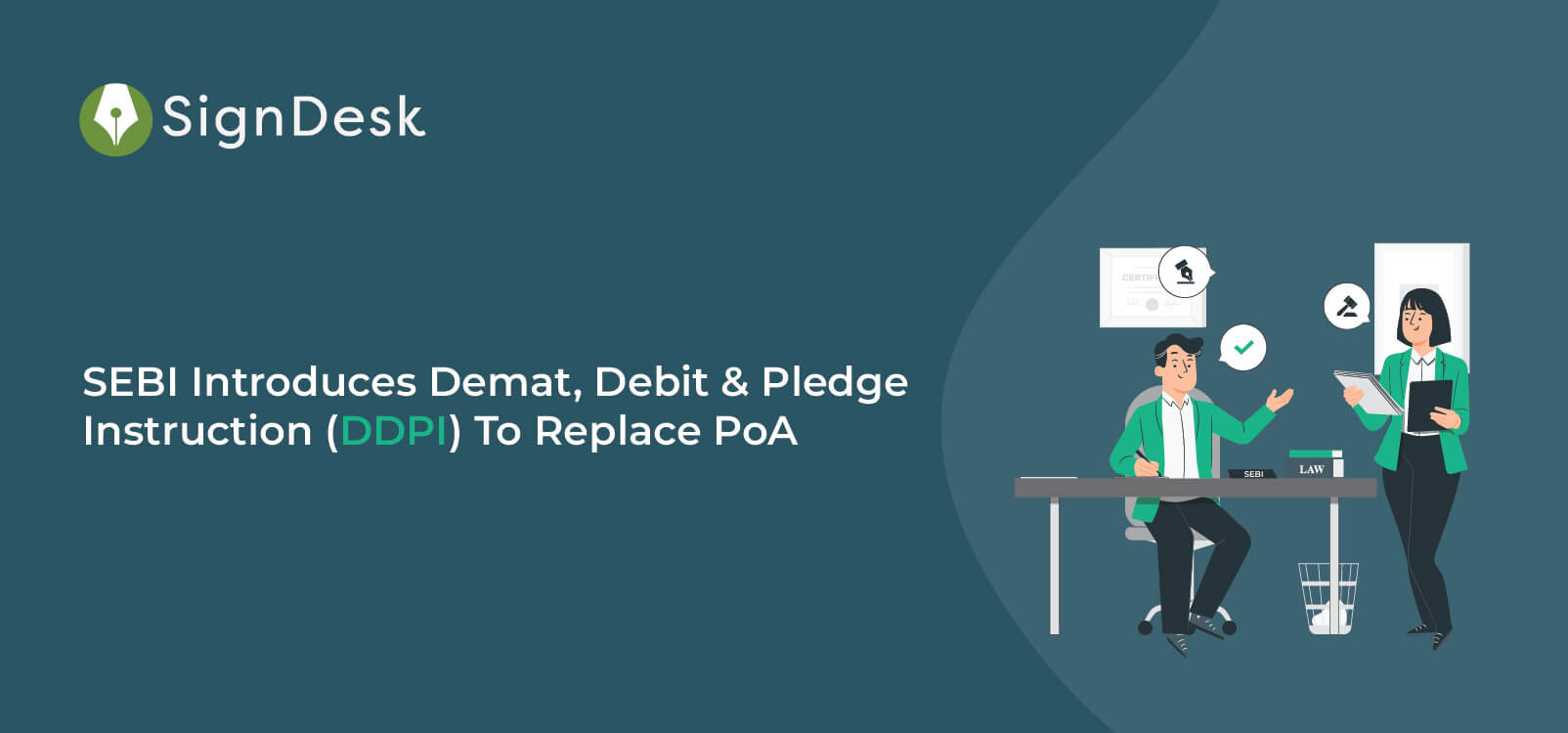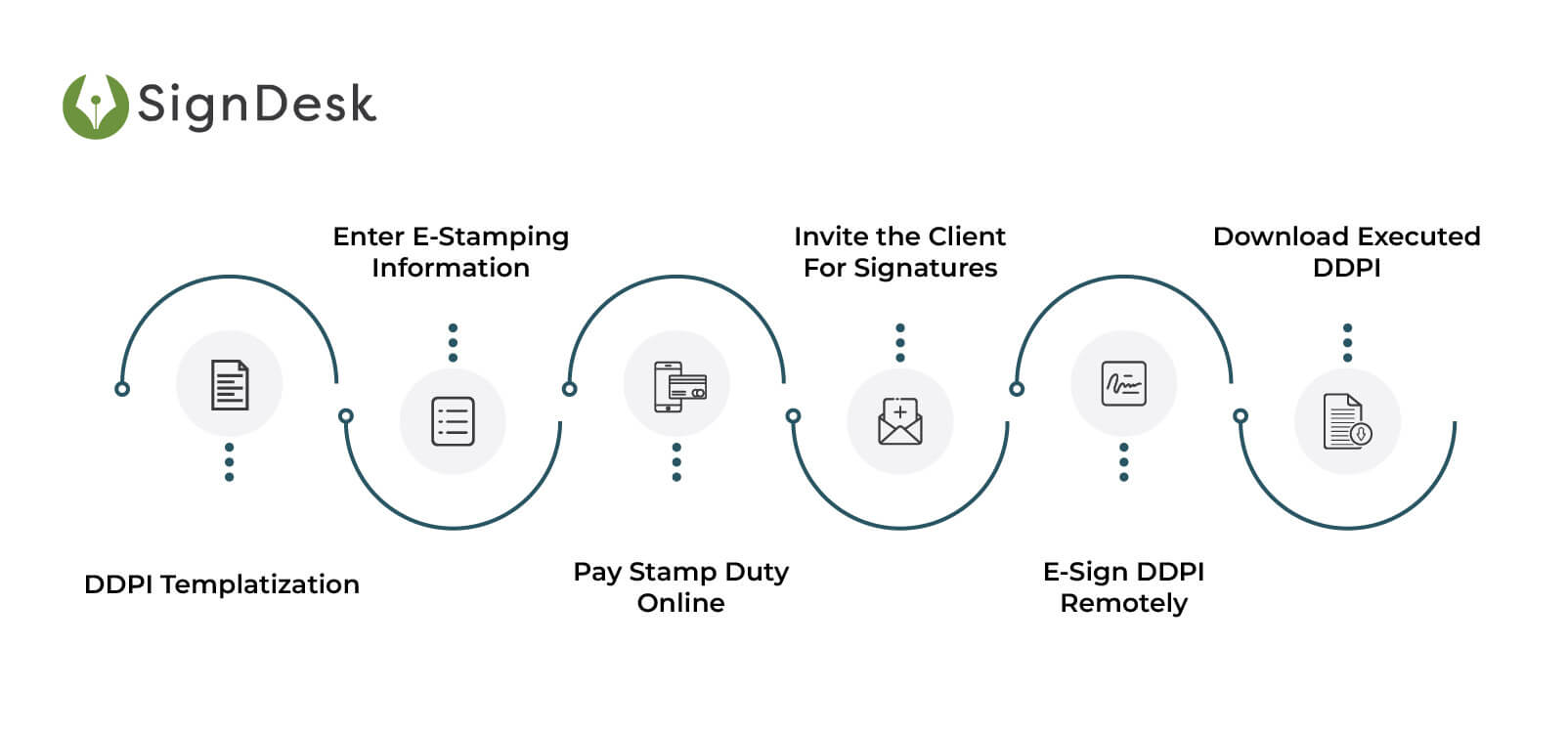
SEBI Releases Fresh Guidelines For PoA & DDPI
The Securities and Exchange Board of India (SEBI) issued a circular dated April 4, 2022, stating that the Power of Attorney (PoA) usually granted to stockbrokers and depositories will no longer be allowed from July 1, 2022.
The PoA will, instead, be replaced by a separate Demat, Debit, and Pledge Instruction (DDPI).
According to the SEBI circular – “The DDPI shall serve the same purpose of PoA and significantly mitigate the misuse of PoA”.
The DDPI will be used for two key purposes originally assigned to the PoA as per the PoA Guidelines of 2020. These two functions are – the transfer of securities and the pledging/re-pledging of securities.
This is not to say that the PoAs currently in use will all be nullified. Existing PoAs will remain valid until revoked by the client, and all PoAs going forward will be optional.
The key difference to note between PoAs and DDPIs is that DDPIs can be eStamped & eSigned, while Schedule 1 of the IT Act states that PoAs can’t be digitally executed.
Key Takeaways From SEBI’s DDPI Circular
- Stockbrokers cannot take PoA from onboarded clients after July 1, 2022.
- PoAs will effectively be replaced by DDPIs.
- DDPIs can be digitally signed and eStamped by clients or executed physically.
- All existing PoAs will still be valid unless revoked by the client.
- PoAs & DDPIs are still optional & brokers must obtain consent from clients before executing either one.
What is PoA – A Quick Refresher
Stockbrokers & depositories are required to obtain permission from investors to conduct transactions on their behalf.
Typically brokers would obtain permission slips for every single transaction, but this is not feasible for brokers and firms with large client bases. Hence brokers have taken to using PoAs as an umbrella solution.
PoAs also needed to be stamped and then signed by both clients and brokers.
With digital execution facilities disallowed for PoAs, brokers and investment firms had to fall back on manual stamp paper procurement.
Stockbrokers & depositories are already familiar with what this entailed.
- Co-ordinating with multiple stamp paper vendors and field agents
- Adjusting client timelines based on inconsistent stamp paper availability
- Delays from non-compliance with stamping laws – stamp paper defacement, errors in stamping details, document execution errors
- Frequent client drop-offs due to slow processing times
- Logistical challenges from document transport, storage & management
- Business loss from long turnaround times and friction in client journeys
With the introduction of DDPI, stockbrokers can leverage digital stamping and eSignatures to overcome these challenges and create a smooth document execution journey for investors.
DDPI – The New Digitally Executable PoA
DDPIs will replace PoAs, effective from July 1, 2022, and can be digitally stamped & signed by clients.
According to SEBI’s circular, DDPIs will be considered “Voluntary Documents”, which means that they will be executed only after obtaining the client’s consent.
Here’s what DDPIs will enable stockbrokers to do, after being eStamped & eSigned –

- Transfer securities held in the beneficial owner (BO) account of clients towards Stock Exchange-related deliveries/settlement obligations arising out of trades executed by clients on the Stock Exchange through the same stockbroker.
- Pledge or re-pledge securities in favor of the trading member (TM)/clearing member (CM) to meet margin requirements in connection with the trades executed by clients on the Stock Exchange.
This essentially means that DDPIs allow stockbrokers to handle securities & make transactions on behalf of clients. But without going through the painstaking manual stamping and signing process of PoAs.
How To eSign & eStamp DDPIs
SignDesk’s Digital Document Execution solution combines templatization, digital stamping & eSignatures to offer a seamless and complete platform for DDPI execution.
Here’s how stockbrokers can get DDPIs eStamped & eSigned securely within minutes.

Step 1: DDPI Templatization
We’ve templatized the DDPI form in our template library.
This means that stockbrokers can choose the DDPI template, make several copies, edit the DDPI template as per their requirements, and push DDPIs to execution in bulk.
Step 2: Enter E-Stamping Information
Once the DDPI template is selected, brokers enter E-Stamping information into the SignDesk portal. This includes first & second-party details, stamp state, stamp paper denomination, document type, etc.
SignDesk can also customize our solution to make sure this information is auto-filled.
Step 3: Pay Stamp Duty Online
SignDesk is integrated with SHCIL (Stockholding Corporation of India Ltd) to enable real-time stamp duty payment on instruments.
Stamp duty is debited from the user’s digital wallet and stamp papers are pre-ordered to ensure availability.
To complete E-Stamping, the DDPI is merged with stamp papers, and an index is printed on each stamp paper, with QR codes created to instantly verify the stamping information.
Physical stamp papers are defaced accordingly and delivered to the broker upon request.
SignDesk’s dashboard allows brokers to track stamping status throughout this process.
Step 4: Invite the Client For Signatures
After E-Stamping the DDPI, brokers can invite clients to sign the DDPI via email or SMS. Clients log into SignDesk and preview the DDPI before eSigning.
Step 5: E-Sign DDPI Remotely
Stakeholders can eSign use electronic or Aadhaar eSignatures to sign via OTP, or digital signatures to execute the DDPI.
Step 6: Download Executed DDPI
The eStamped and eSigned DDPI is finally downloaded by all stakeholders. An audit trail is also created for document activities.
How Can Stockbrokers & Depositories Comply With The New SEBI DDPI Rules?
Here’s what we know so far.
- The powers granted by PoAs to stockbrokers make them too convenient to not use, notwithstanding the massive logistical challenges
- DDPI has essentially replaced PoA but allows for digital execution, offering a solution to these challenges
- Brokers and directories must quickly transition to using DDPIs, for which they need to integrate with eSign and e Stamping solutions.
With this in mind, stockbrokers and investment directories are in one of three possible scenarios.
Scenario 1: No digital infrastructure in place
Technically, DDPIs can still be executed manually. This means following the same execution process as with PoAs – procuring stamp paper from vendors and then getting the DDPI signed with written signatures.
However, this would result in the same challenges and issues as PoAs and a similar degree of inconvenience and friction.
For businesses new to the document automation space, SignDesk offers an eStamp and eSign API that can be easily integrated into any document management system with no third-party assistance.
We also provide onboarding training to help brokers hit the ground running.
Our close working relationship with SHCIL and stamp paper vendors across India enable us to maintain low TATs for stamping and smooth operations. Our eStamp & eSign API is also intuitive to use and has helped several lending groups in large banks streamline their document execution process, reduce expenses and improve customer satisfaction.
Scenario 2: Either E-Sign or E-Stamp integration present
The difference between integrating with just E-Sign or E-Stamp as opposed to both is the same as hopping on one leg versus running on both.
Brokers relying on just one of these solutions will be well aware of the pitfalls that accompany switching to a different platform or even workflow to conduct eStamping or eSigning.
These include delays from having to make adjustments for switching from E-Stamping to written signatures or physical stamping to E-Signatures and efficiency losses due to context switching.
Documents will have to be printed and re-printed, scanned several times, and manually moved between different stakeholders. The document execution process needs to be seamless, both for business efficiency and to boost customer experience.
SignDesk’s combined eSign and eStamp solution is a one-stop platform for digital document execution, enabling brokers to both digitally stamp and sign documents.
Brokers can create DDPIs in bulk, get them all eStamped in one go, and invite multiple signers to eSign every DDPI remotely. Our transparent & audit-ready workflows enable directories and firms to onboard clients securely and quickly.
Scenario 3: Digital Document Execution System already present
Stockbrokers with a strong digital document execution in place are doing something right, but there’s a lot more that needs to be done.
Most digital execution solutions are not fully equipped to handle the transactional, operational, and compliance-related aspects of bulk documentation.
- The eSign or eStamp service you use might not really be compliant
Take it from us, creating a compliant digital stamping solution is tough. This is because of the various stakeholders and laws involved, and the need to collaborate with different regulatory bodies.
It might turn out that the eStamp or eSign service you’re using might not really comply with the IT Act or the various stamping laws at the state level.
With SignDesk you can rest assured that the digital document execution process is fully compliant with all the requisite laws. Our solution has been analyzed by independent legal experts and is currently leveraged by several private and commercial banks.
- The eSign/eStamp service you use could be incapable of scaling
Stockbrokers will need to create a DDPI for every client onboarded, meaning that the document execution solution used needs to be scalable.
Otherwise, firms and directories will be stuck with the same slow and inefficient investor onboarding process as before and will be unable to grow their operational capacities.
SignDesk offers scalable and customizable document execution solutions built for bulk workflows. Brokers can push documents for eStamping en masse and get them all eStamped at once.
- Your service provider might not have strong operational capabilities
Digital stamping requires robust backend operations to ensure compliance with stamping laws.
Stamp papers need to be procured, checked, defaced, managed, and delivered according to schedule. This requires a strong and flexible team to coordinate the entire process.
Most service providers simply haven’t built up these capabilities or the business relationships required to conduct nationwide eStamping operations.
SignDesk is ISO 9001 certified for operations and boasts considerable operational capabilities, with real-time status tracking, maker-checker principles to ensure accuracy, and strong working relationships with key regulatory bodies such as SHCIL, NSDL, and more.
- The eSign or eStamp service you use might not be adaptable or customizable
If your eSign or eStamp provider was rushing to make changes after SEBI’s DDPI circular, you’ll know that they aren’t adaptable.
An indicator of flexible service providers is how quickly they can adapt their solutions to regulation changes and how fast their solutions go live.
At SignDesk, our eSign and eStamping solutions are designed for quick customizations so that simple regulation changes are easy to incorporate. All we had to do was configure a DDPI template and our document execution solution was ready for investor onboarding.
What’s Next For Stockbrokers & Investment Firms?
With July 1, 2022, being the last date for stockbrokers and directories to do away with PoA and utilize DDPI, brokers must move quickly to ensure compliance with SEBI’s directives.
Here’s what brokers need to digitally execute DDPIs and onboard investors –
- Configurable DDPI templates to onboard investors in bulk
- Robust & proven digital stamping capabilities to eStamp DDPIs
- Electronic signatures to get DDPIs eSigned remotely
- Quick integration with onboarding support, account management, and dedicated DevOps teams to set up digital execution systems and ensure smooth operations
SignDesk offers brokers these capabilities and more. Book a free demo with us now to discuss how we can get your eSign & eStamp solution up and running.